The Split Leaf Philodendron is a gentle jungle giant that has enthralled houseplant enthusiasts for decades. Impossible not to love, this beauty can be identified by its large, glossy green leaves and the deep splits or indents for which it is named.
Furthermore, and unsurprisingly for a philodendron, the Split Leaf is delightfully low-maintenance and a quick and gratifying grower. Although it doesn’t climb or trail, it more than makes up for it with a sprawling growth habit that often renders it broader than it is tall – making it a real showpiece in the home.
In this article, we’ll look at everything there is to know about the Split Leaf Philodendron, from identifying different varieties to how to care for them and keep them healthy. Ready? Let’s dive right in.
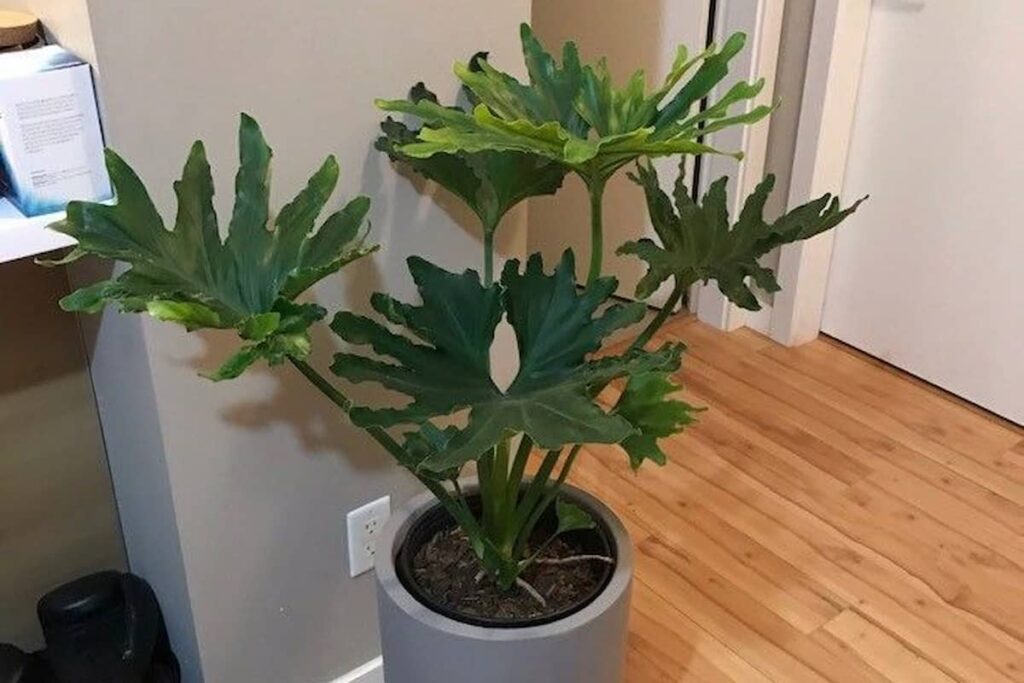
Table of Contents
What are the types of Split Leaf Philodendron?
Currently, there are two known varieties of philodendron that go by the moniker Split Leaf, namely the Philodendron Bipinnatifidum and the Philodendron Selloum. Though many believe they are, in fact, the same plant, there is evidence to suggest they have slight physiological differences.
Although the Split Leaf Philodendron is fairly simple to identify, thanks to its distinctive leaves, there are quite a few plants out there that share its aesthetic traits. This can make it confusing to distinguish, especially in its juvenile phase.
Scientifically, we know that the two varieties of philodendron that fall under the Split Leaf nickname are the Bipinnatifidum and the Selloum. These two cultivars are borderline identical, barring minor differences in coloring and growth rate.
However, other philodendrons, like the Xanadu or the Minima, are so similar in looks that they are often mistakenly labeled as Split Leaf. Irrespective, they are a lot smaller in size.
Further compounding this identity crisis is the case of the Monstera Deliciosa, affectionately known as the Delicious Monster. Though equally beautiful, the Deliciosa is from a different genus of plants altogether (i.e., Monstera) – it just happens to share an uncanny resemblance to the Split Leaf Philodendron, especially if you don’t know what to look out for.
How do you tell the difference? True Split Leaf Philodendrons are aroid plants hailing from South and Central America that grow to be up to 15 feet tall (3 meters) and equally broad.
Their key difference between Split Leaf Philodendrons vs Monstera Deliciosa is that their leaves are split from the edges inwards rather than fenestrated. Their leaves are also smaller and more heart-shaped (rather than oval).
Are Split Leaf Philodendrons hard to take care of?
Like most plants in the philodendron family, the Split Leaf Philodendron is easy to care for and requires very little maintenance. With regular watering, a decent amount of light, nutrient-rich soil, and a warm, humid environment, you should have no problem helping your Split Leaf thrive.
Whether you’re a seasoned houseplant collector or an absolute beginner, you won’t be disappointed by the Split Leaf’s easy-going nature. Indeed, establishing a sound system of care for your plant is straightforward, provided you keep its basic needs in check regarding sun, soil, water, and warmth.
To start, you want to ensure your Split Leaf has plenty of access to light. Indirect light for 6 to 8 hours per day is ideal, as direct sun can scorch its leaves. To this end, I recommend placing your philodendron a few feet back from a sunny window.

In terms of soil, a Split Leaf’s statuesque dimensions require that it absorbs a fair amount of nutrients and minerals to bolster its growth and health. You should select a quality soil (or a specialty blend) for your plant that is well-draining and has added perlite for air circulation. Soil should be kept moist with weekly watering.
Best soil for Philodendrons
Miracle-Gro Tropical Potting Mix
Light and well-draining (perfect for avoiding root rot) while being packed with just the right nutrients – that will feed your plant for up to six months. The best soil for keeping your philodendron healthy and strong.
Finally, and perhaps most key to keeping a Split Leaf Philodendron happy, is the question of warmth and humidity. Much of this occurs naturally in a sunny home environment.
However, humidity can be supplemented by keeping your houseplants clustered together or investing in a small plug-in humidifier.
How long does a Split Leaf Philodendron live?
Given their robust natures and no-fuss care requirements, it should come as no surprise that Split Leaf Philodendrons have a lengthy lifespan. With consistent maintenance in terms of watering, soil, light, pruning, and repotting, the Split Leaf can live for up to 20 years indoors.
In fact, in the wild, they have been known to survive for over 100 years.
Split Leaf Philodendron lovers are in it for the long haul, as these beauties are one of the longest-living houseplants available. Once your plant is settled and you have your care regime down to a tee, there’s no reason that you can’t enjoy it for many, many years to come.
As discussed in the previous section, the Split Leaf Philodendron subscribes to a low-maintenance lifestyle. But even so, there are additional measures you can put in place to ensure it remains healthy, especially as it grows older.
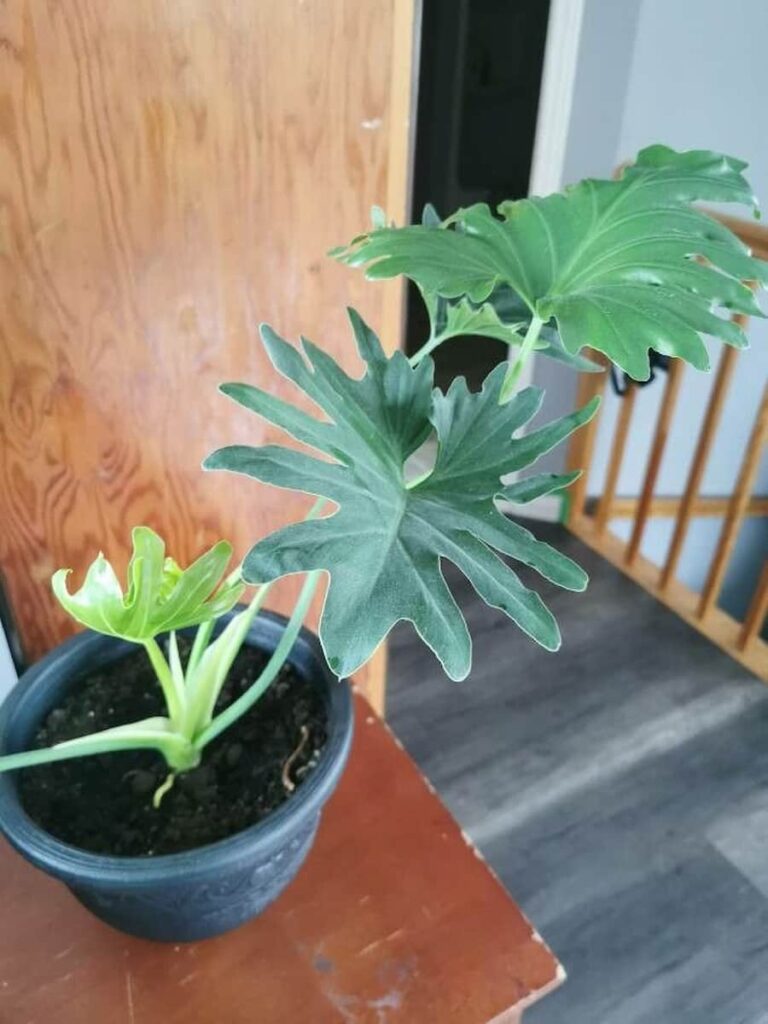
For example, larger specimens may require extra nutrients, which you can supplement with occasional doses of slow-release liquid fertilizer.
Furthermore, occasional pruning to remove dead growth is also beneficial. This deters your plant from expending its energy on retired growth, instead redirecting it for new foliage and root development. This is also a great way to keep your plant shapely and aesthetic.
Although the Split Leaf Philodendron is not prone to pests or diseases, I recommend giving it a once-over every now and then to ensure no creepy crawlies have found their way onto your plant.
Older philodendrons also enjoy having their leaves wiped down to stop them from becoming dusty – which can impede photosynthesis.
How to care for a Split Leaf Philodendron
The best way to care for a Split Leaf Philodendron is to try and emulate its natural, tropical environment. This involves providing it with bright, indirect light, plenty of warmth and humidity, well-draining soil, good hydration, and seasonal feeding. Occasional pruning and cleaning also help your Split Leaf Philodendron’ overall well-being.
Split Leaf Philodendron make great houseplants, and if you have any hesitation about their care, worry no further. These gracious green beauties are low-maintenance and straightforward in terms of their needs, making them perfect for even beginner plant parents.
Bearing in mind that Split Leaf Philodendron are tropical plants, the best environment you can offer them is one where they’ll have a sunny spot with lots of light, relative humidity, and plenty of moisture.
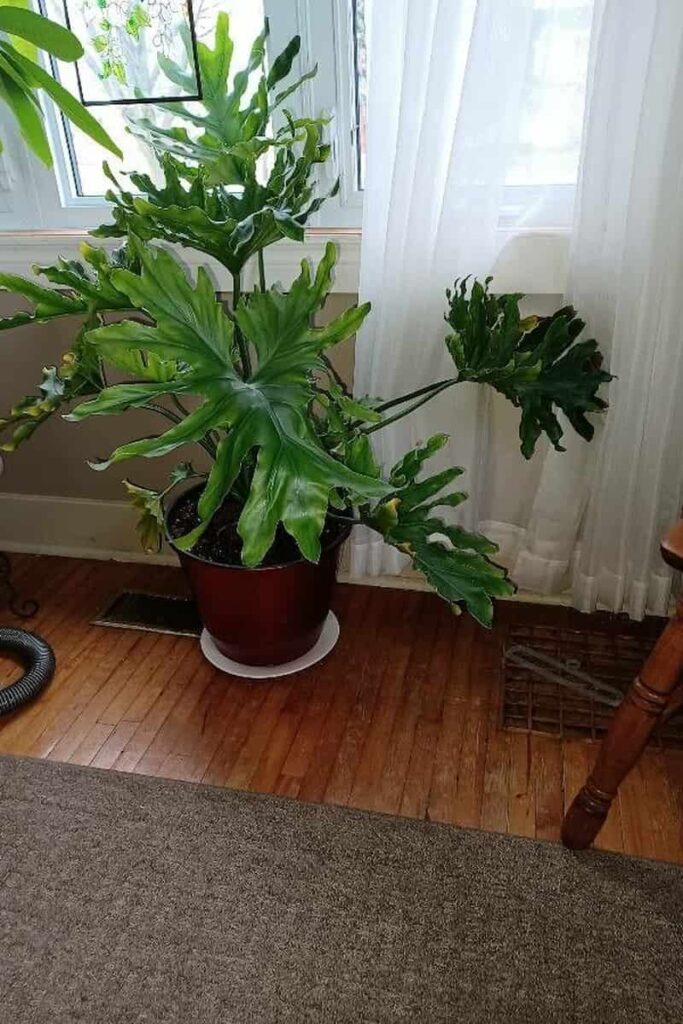
In good news, most homes are already set up for this with East and South-facing windows and a generalized humidity level of around 50%.
To supplement the rest of their care needs, you just need to ensure your Split Leaf Philodendron stays hydrated, is fed with both good soil and that you occasionally fertilize your philodendron.
My top pick: My recommendation for the best fertilizer for your Split Leaf Philodendron is EZ-Gro 20-20-20 All Purpose Liquid Fertilizer.
It’s extremely easy to use and has the perfect balance of nutrients for Split Leaf Philodendron. You can check the latest price here.
In the following sections, we’ll look at Split Leaf Philodendron care in greater detail to equip you with everything you need to help your houseplants thrive.
How much light does a Split Leaf Philodendron need?
Split Leaf Philodendron prefer at least six to eight hours of bright, indirect sunlight each day. As their leaves can be vulnerable if they receive too much light, keep an eye out for any signs of sunburn on your Split Leaf Philodendron’s leaves, such as yellowing leaves or brown spots appearing.
Most (if not all) plants depend on sunlight energy to grow, and Split Leaf Philodendron are no different. Native to tropical America, they’re accustomed to dappled light from the jungle canopies above them, which you can try to mimic in the home with clever positioning.
In the winter, when it starts to cool down, and there is less indoor sun available, a Split Leaf Philodendron’s light needs can be augmented with a bit of time spent outdoors on a sheltered patio or balcony. The fresh air will do them good, too.
Find out more: Philodendron Light Needs: The Ultimate Guide
What is the right temperature for Split Leaf Philodendron?
Your Split Leaf Philodendron will thrive in temperatures between 75°F and 85°F (23°C to 29°C). While they can survive at lower temperatures than this, don’t let them stay for too long anywhere less than 65°F (18°C) as your plant may not survive.
Clearly some plants, like Split Leaf Philodendron, like it hot. However, the real kicker is ensuring your Split Leaf Philodendron are placed in an area with mid-to-high humidity.
What are the best humidity levels for a Split Leaf Philodendron?
Split Leaf Philodendron prefer humidity levels of around 65% to 80%. Given that they are native to tropical Central and South America, they thrive in humidity conditions similar to their natural habitat. However, most homes won’t reach these levels, so you may need to boost this for your Split Leaf Philodendron to thrive.
Houseplants that receive adequate amounts of sunlight daily generally don’t require supplementary humidity, particularly if you consider most homes fall in the 40% to 50% range. However, with their tropical inclinations, Split Leaf Philodendron can benefit from a little extra care in this regard.

The easiest, in my opinion, is to invest in a small plug-in humidifier. Alternatively, you can rest your Split Leaf Philodendron on a damp pebble tray, making sure not to let their roots touch the water.
Alternatively, if you have a whole collection of houseplants, cluster them together so they can benefit from each other’s transpiration processes. It has the added benefit of looking great too!
What soil is best for Split Leaf Philodendron?
A Split Leaf Philodendron’s soil mix should be loosely clustered, nutrient-rich, and well-draining. The high nutrient level emulates its natural habitat, where plant material in the rainforest falls onto Split Leaf Philodendron and nourishes them. Having light and airy potting mix helps to avoid the soil staying too soggy, which can lead to root rot.
While many Split Leaf Philodendron varieties have aerial roots as well as ground-dwelling (terrestrial) roots, they receive the bulk of their vitamins and minerals from their soil, making it an essential part of their fundamental care.
Top pick: My preferred soil for Split Leaf Philodendron is the Miracle-Gro Tropical Potting Mix (check the latest price here).
It’s very well draining and will feed nutrients to your Split Leaf Philodendron for up to six months. For a tropical plant like the Split Leaf Philodendron, it’s got everything you need.
Buying pre-blended Split Leaf Philodendron soil from most garden centers is a simple option. Alternatively, you can easily mix your own by combining potting soil with chunky bits of bark (grab some here) and moisture-retentive perlite (get it here).
If you’re buying your Split Leaf Philodendron pre-potted, they’ll likely arrive in appropriate soil from the get-go. Even so, you’ll need to replace their soil every 18 to 24 months to prevent a build-up of salts or eliminate any beasties and creatures like pests, fungi, or bacteria, so make sure you’re replanting them in the best soil for philodendrons so they continue to thrive.
Indeed, this is a good maintenance practice for all houseplants, not just Split Leaf Philodendron!
How often should you water Split Leaf Philodendron?
You should water your Split Leaf Philodendron when the top two inches of its soil has dried out, which you can test by sticking your finger into your plant’s potting mix. In summer, this will be around once per week, but may be less frequent in the cooler months.
It’s always good to have a watering schedule for your plants, but with so many factors (like season and sunlight) at play, I prefer to meet my Split Leaf Philodendron’s watering needs as required – by waiting for their top inch of soil to dry out before hydrating.
The reason for this is that the leading cause of fatality in Split Leaf Philodendron is root rot, which they tend to contract from overly soggy soil or from standing in pooled water. As they’re pretty drought-tolerant, it’s best to err on the side of caution and only water philodendrons as they need it rather than strictly once-per-week.
That said, when you do water them, a hearty dose of moisture is great, provided it doesn’t make their soil soggy and heavy, which weighs down on their root systems.
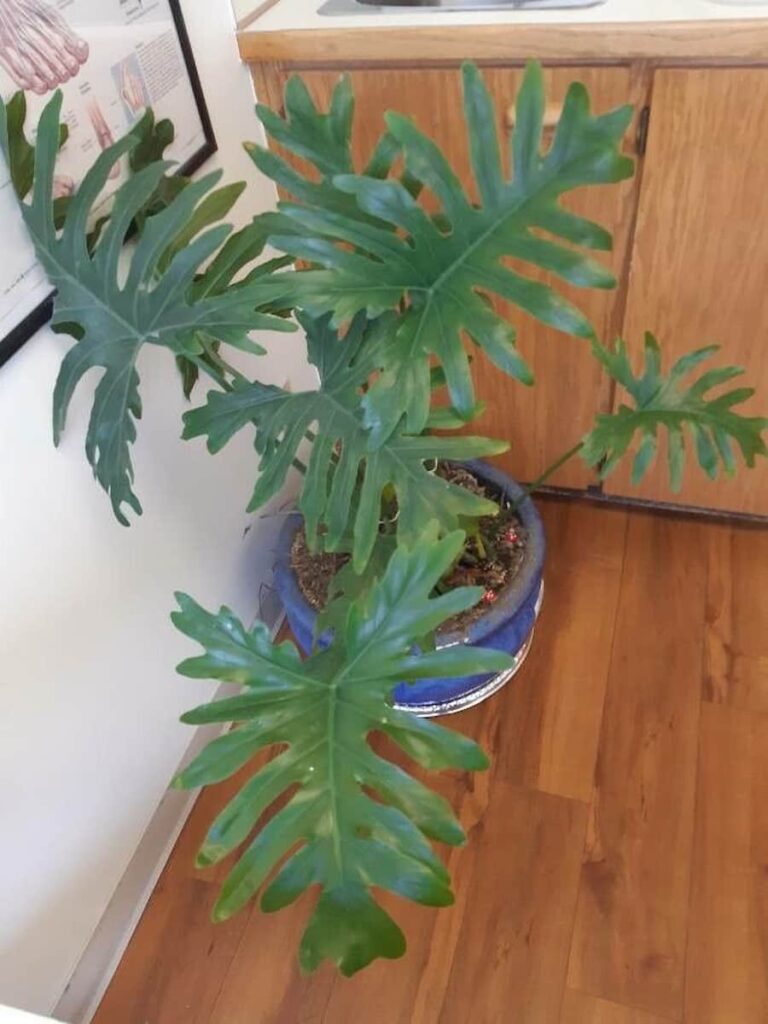
When should I fertilize my Split Leaf Philodendron?
Split Leaf Philodendron likes some fertilizer every now and again. In fact, they do their best when they are fed twice a month during their active growing season, which is the spring and summer. However, you shouldn’t fertilize your Split Leaf Philodendron during its dormant period in the cooler months.
This is because feeding the plant during this time can interfere with its natural growing cycle.
Overall, though, occasional feeding with a balanced fertilizer is greatly beneficial for Split Leaf Philodendron, especially at the start of their growing seasons in the spring and summer months.
Best fertilizer for Philodendrons
Jack’s Classic 20-20-20 All Purpose Fertilizer
A great fertilizer with the perfect balance for your philodendron. Simply dissolve in water and feed your plant to watch it thrive.
If you think about it, these jungle-dwellers are used to all the rich, dense nutrients they have access to from the forest floor, which can’t be substituted by typical potting soil.
An all-purpose liquid fertilizer at half strength is a good way to replace their natural feeding schedule, providing them with an extra dose of energy for new growth.
Should I prune my Split Leaf Philodendron?
You should prune your Split Leaf Philodendron from time to time as part of their regular maintenance, with spring being the best time of the year to do this. Removing dead foliage or browning stems will allow robust leaves and vines to draw in more sunlight and stop your plant from wasting energy.
Just like humans shower, cut their hair, and clip their nails, Split Leaf Philodendron can do with occasional grooming, especially when it comes to eradicating old or dying growth. Fortunately, trimming your philodendron really isn’t hard to do.
When it comes to cleaning, remember that each large leaf of your Split Leaf Philodendron is full of sunlight receptors that are easily blocked by dust or grime. Wiping down your leaves with a damp cloth keeps them clean and free to function at their best.
When should I repot my Split Leaf Philodendron
The Split Leaf Philodendron is not a plant that needs to be repotted regularly, with it often only needing to be transplanted every two to three years. With that said, however, you should repot your Split Leaf Philodendron if you see roots growing out of the drainage holes.
In fact, this plant does well when it is rootbound. That said, when you do transplant a Split Leaf Philodendron, do so in spring before the plant starts to produce new growth, and select a pot that is about 3 sizes larger than the current pot.
Alternatively, you can wait until fall to perform the transplant.
Find out more: 7 Simple Steps to Repot Philodendrons (+ When To Do It)
Do Split Leaf Philodendrons like to be root bound?
Split Leaf Philodendrons do not enjoy being root bound, as it can negatively impact their ability to grow and thrive. Philodendron root systems without sufficient space won’t be able to expand, which in turn hampers their capacity to transport nutrients and oxygen to the rest of the plant.
One of the primary causes of stunted growth in a Split Leaf Philodendron is insufficient space in its planter. When this happens, your plant becomes root bound, meaning there is no space left to develop new growth or to continue its usual biological processes.
To identify if your Split Leaf Philodendron is root bound, there are two factors to look out for, namely slowed growth and signs of roots peeking out from your planter’s drainage holes.
Should you notice either of these symptoms, it’s time to repot your plant. Don’t go too wild in terms of size. A planter 30% wider and deeper will do just fine. And while you’re at it, replace your Split Leaf’s soil, as this will give it a fresh kick of nutrients.
As a general rule of thumb, you can expect that your plant will need repotting every 18 to 24 months, especially in its first 5 to 10 years of life.
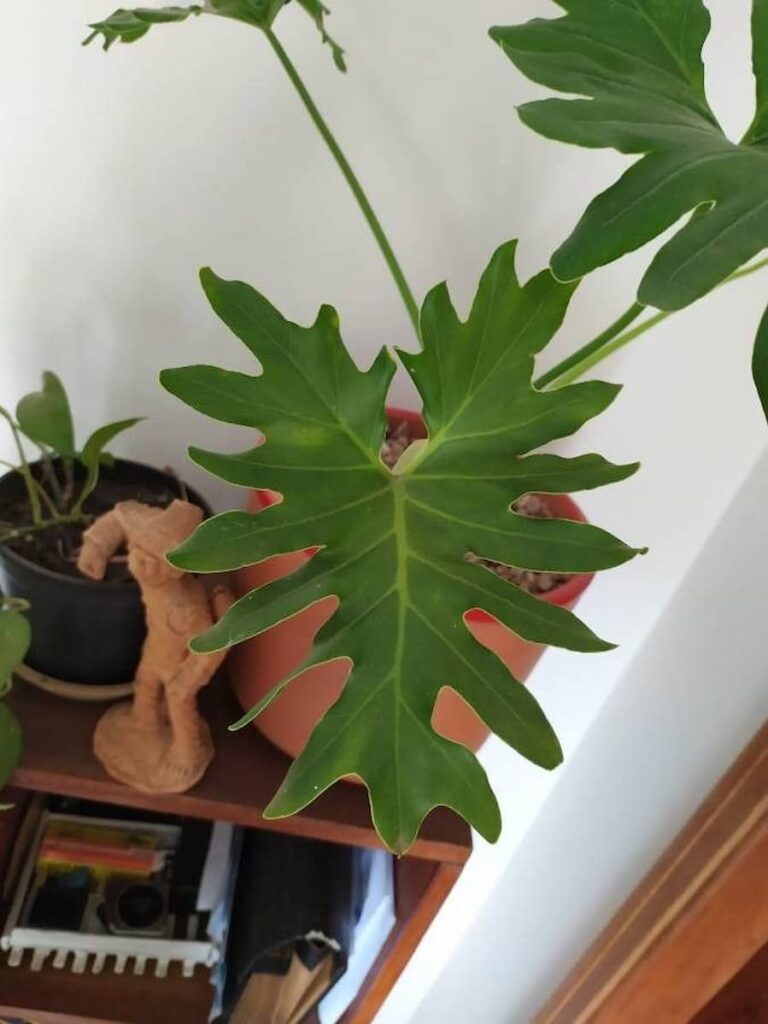
Do Split Leaf Philodendrons grow fast?
The Split Leaf Philodendron is considered a rapid grower and can expand by as much as 4 inches (10 centimeters) per week during spring and summer. That said, its growth rate depends on environmental factors such as light, water, and humidity.
In particular, the more closely your home emulates the Split Leaf’s natural tropical environment, the faster it will grow.
This beautiful philodendron can only be described as rewarding, especially if you’re looking for a plant that will flourish in size quickly. The Split Leaf grows just as fast, if not more so, than many smaller varieties in the same family.
Of course, it follows that it will thrive best if all its needs are met. While it remains a low-maintenance plant, it does like consistency, especially regarding hydration, nutrients, and temperature. You can also expect most of its development to occur in spring and summer.
Should you notice slowed or leggy growth, your Split Leaf may be trying to communicate that its needs aren’t being met. Review your plant’s environment, and if necessary, move it to a spot with more light, adjust your watering practices, or consider supplementing your home’s humidity levels.
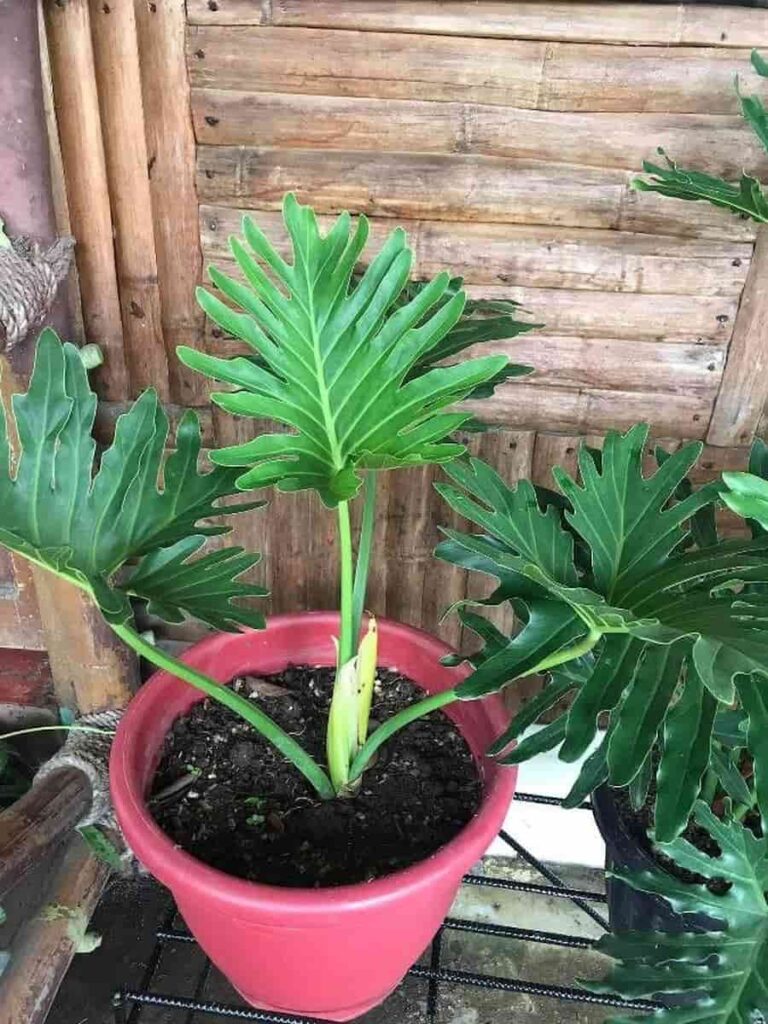
Do Split Leaf Philodendrons clean the air?
Split Leaf Philodendrons are not only loved for their good looks. They also have natural air-purifying qualities that make them a great addition to the home. Plants in the philodendron family are proven to filter harmful toxins like formaldehyde from the air, rendering it cleaner and purer.
While there are numerous benefits to having plants in your house or office, chief among these is their ability to clean the air around them. And the Split Leaf Philodendron is a great candidate for this exact purpose.
Indeed, research has shown that philodendrons filter harmful chemicals that pollute the air, like formaldehyde, ammonia, and benzene, absorbing and eliminating them. At the same time, Split Leaf Philodendrons also give off oxygen, making your environment feel fresher overall.
How to propagate a Split Leaf Philodendron
The easiest way to propagate your Split Leaf Philodendron is to root it in water. Simply place your cutting into a jar with water in it and place it in a warm sunny spot, and wait. Refresh the water once a week to keep it oxygenated and, in six to eight weeks, new roots will appear.
At that point, your Split Leaf Philodendron cutting will be ready for transplantation!
Split Leaf Philodendron can be propagated from stem cuttings, provided they have a visible node and a leaf or two to draw in moisture from the air. You can either root your cuttings in water first or plant them directly into soil.
Alternatively, if you only have a small piece of stem, you can try to root them in a nutrient-rich growing medium with concentrated humidity.
That is, a second option is to place your cutting directly into a planter with soil. This is slightly riskier as they require a lot of humidity to make up for the moisture they’d usually draw via roots, but it can be equally effective with proper care.
If your cutting has no leaves, try laying it on a bed of peat moss and covering the tray or container with plastic to retain humidity. While this method isn’t always effective, it’s worth a try to avoid throwing away any pieces of your precious plants.
Find out more: 10 Easy Steps to Propagate Philodendron Cuttings
Where to find a Split Leaf Philodendron for sale
As a commonly known and well-loved houseplant, Split Leaf Philodendron are easy to find and can be purchased from most nurseries or garden centers. To buy them online, Etsy is always a good option. Rarer varieties can be bought from online merchants or specialized breeders or traded among collectors.
In the mood for a Split Leaf Philodendron? You’re in luck. These beauties are freely available on the market and are considered one of the most popular houseplants around.
Of course, if you’re after rare collector’s items, you may need to double down on your search and rely on specialists. But if you’re simply looking for some of these beauties to adorn your home (which is definitely a good idea!), you can pop out and get one from your local nursery today.
How do you make a Split Leaf Philodendron bushy?
The best way to make a Split Leaf Philodendron bushy is to prune it in its growing season, which is spring and summer. Make sure you remove any dead or dying leaves, as this ensures your plant doesn’t spend energy on this foliage and will instead focus on new growth.
Funnily enough, regularly trimming your plant is actually key to maximizing your philodendron’s growth rate.
Regularly turning your plant so that all its angles receive sunlight is another good way to ensure consistent, rounded, and aesthetic growth with a clustered appearance to make your philodendron fuller.
You can also use a moss pole so that your Split Leaf Philodendron has space to climb upwards, which is what it would do in its natural environment – aiming upwards towards a source of light.
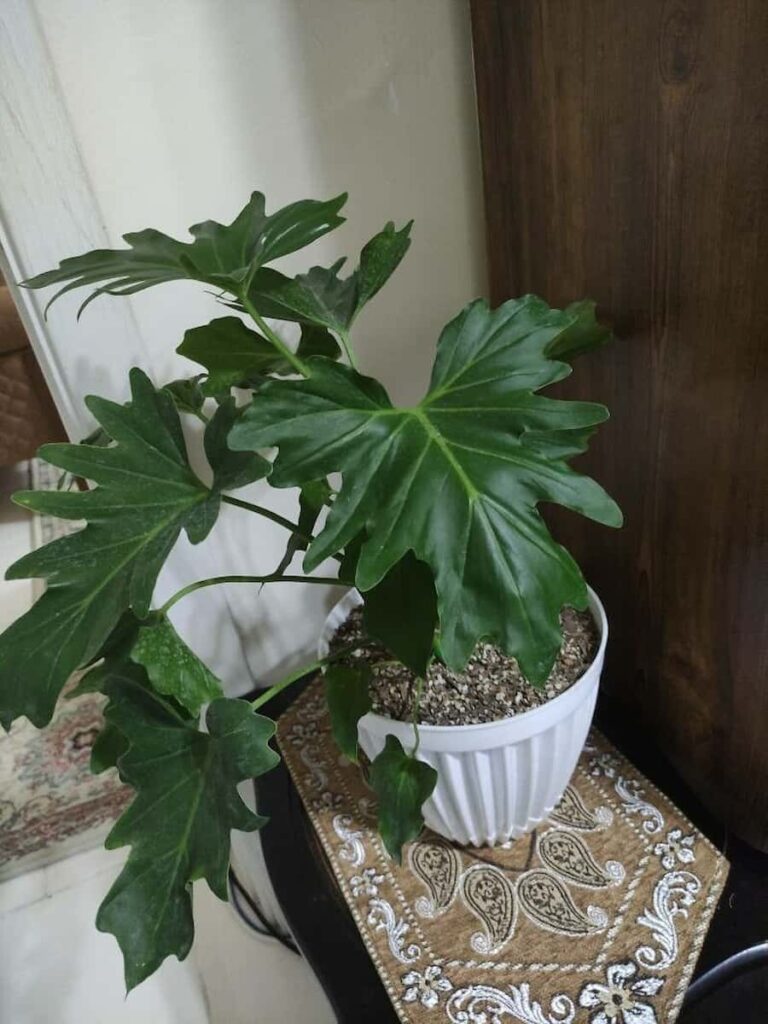
Are Split Leaf Philodendron toxic?
Split Leaf Philodendron are toxic to humans and animals, as they contain sharp calcium oxalate crystals that cause skin irritation through direct contact, or gastrointestinal distress and other potentially dangerous symptoms when ingested. All parts of the plant contain these crystals, which are most prevalent in its sap.
While Split Leaf Philodendron are indisputably beautiful in the home, it is best to keep them away from curious kids and pets, as skin contact and ingestion can be highly irritating at best and have real health consequences at worst.
These plants’ sticky white sap is full of needle-like calcium crystals. When they make contact with bare skin, they can cause welts or irritating rashes, which, fortunately, can usually be treated with a topical skin ointment.
Be aware: Ingestion of any part of a Split Leaf Philodendron can cause swelling of the throat tissue, nausea, dizziness, diarrhea, and other symptoms of gastrointestinal distress. In a worst-case scenario, ingestion can cause difficulty breathing, in which case, medical treatment should be sought as a matter of urgency.
While this all sounds very daunting, the good news is that these plants don’t taste good, so there is no real reason (other than curiosity or carelessness) why rogue children or pets would eat them. Even so, prevention is better than cure, so place your plants out of reach if you’re concerned they may get chomped.
Why is my Split Leaf Philodendron crying?
Tiny water droplets on the tips of a Split Leaf Philodendron’s leaves result from a phenomenon colloquially referred to as “crying.” Although this is no cause for concern, it indicates that your plant has too high a moisture saturation, which it is trying to shed through its foliage.
Have you ever noticed tiny water droplets forming on the tips of your houseplant’s leaves? This is called guttation and is generally a sign of overwatering. But never fear. It is no reason to panic but rather a way for your plant to tell you that there is too much moisture in its soil.
Occasional “crying” is perfectly normal and easily remedied by adjusting your watering practices. Overwatering can be incredibly detrimental in the long term, allowing for the growth of nasty bacteria and fungi that, in turn, can develop into root rot.
For this reason, it’s good to listen to your plant when it’s trying to communicate rather than letting guttation continue indefinitely.
Do Split Leaf Philodendrons climb?
The Split Leaf Philodendron is not a vining or climbing variety; instead, it is self-heading. This means it grows upright stalks on solid stems that reach upwards from a centered root system. As it grows larger and its leaves get bigger and heavier, it may require some support to prevent its stems from snapping.
Unlike many other varieties of Philodendron, the Split Leaf is not a climber. Instead, it grows in a clustered fashion, producing multiple leaves from strong, upright stalks in a manner that can be described as bushy. As its leaves grow more prominent, the stems tend to curve downwards, accounting for its sprawling appearance.
That said, trellises and similar structures can be utilized to “train” your Split Leaf to grow in a particular direction or formation, especially in combination with turning your plant for equal light distribution. This serves the additional benefit of supporting its stems (due to its heavy leaves), which may require staking as your plant matures.
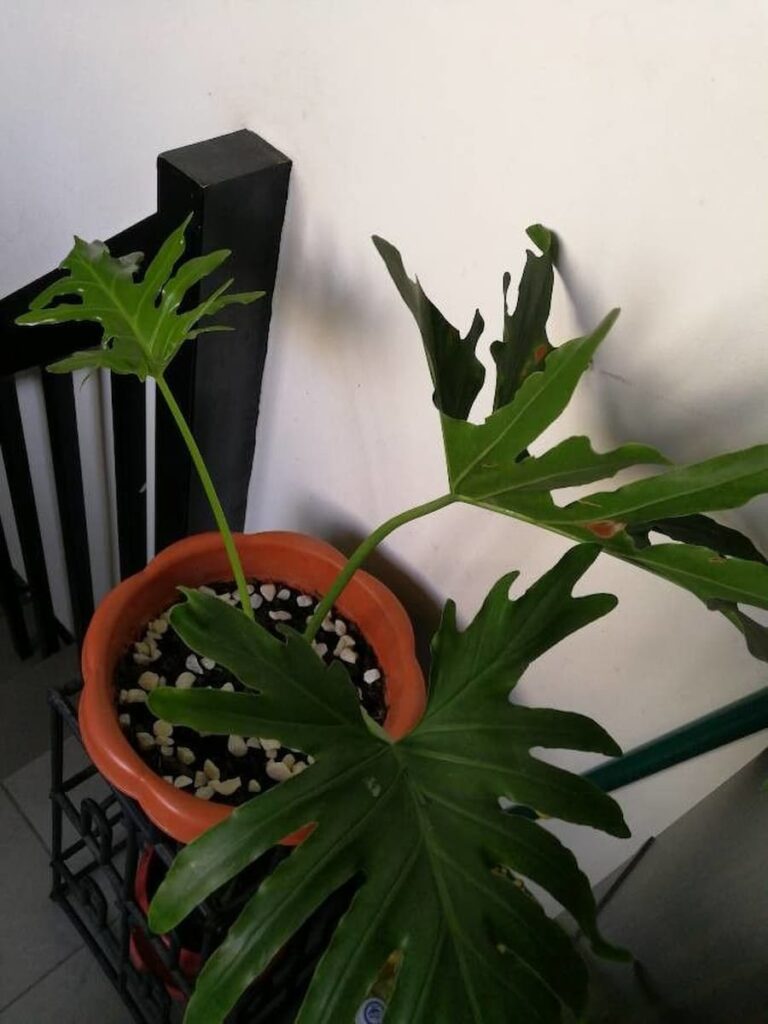
Can Split Leaf Philodendrons grow outdoors?
Split Leaf Philodendrons are hardy plants that can fare equally well outdoors. However, it is beneficial to note that their natural environment is tropical and partially shaded, so when selecting an outdoor spot for your Split Leaf, aim for a sheltered area with predominantly indirect light.
Also, much like their native habitat, warmer climates (USD Zones 9-11) are preferred.
Whether your Split Leaf has become too large for your home, or you’re simply looking for a jungle giant to add to your landscape, the good news is that this philodendron has no issue thriving outdoors, provided you live in a relatively warm environment.
This is because the Split Leaf is ultimately tropical and loves a humid, hot living space that is temperate year-round.
Together with this, there are also a few things to look out for when selecting a spot for your Split Leaf in the garden. Philodendrons don’t like direct sun, so a shaded or sheltered location in a bright area will suffice.
They’re also not a huge fan of the wind, so opt for a site against a larger tree or wall that can offer protection.
Why are my Split Leaf Philodendron’s leaves turning yellow?
There are a few reasons why Split Leaf Philodendron leaves turn yellow, but the primary cause is overwatering, with yellowing leaves being an early sign of root rot. Damaged roots cannot transport nutrients, oxygen, and water to a plant’s leaves, which causes cell death, and by default, turns them yellow.
I find watering my plants to be the most cathartic exercise on earth. However, with some trial and error, I’ve learned that my Split Leaf Philodendron, in particular, doesn’t do well with being over-loved.
While they’re super hardy, too much hydration can quickly cause root rot in philodendrons – a fungal or bacterial infection that destroys your plant’s root system.
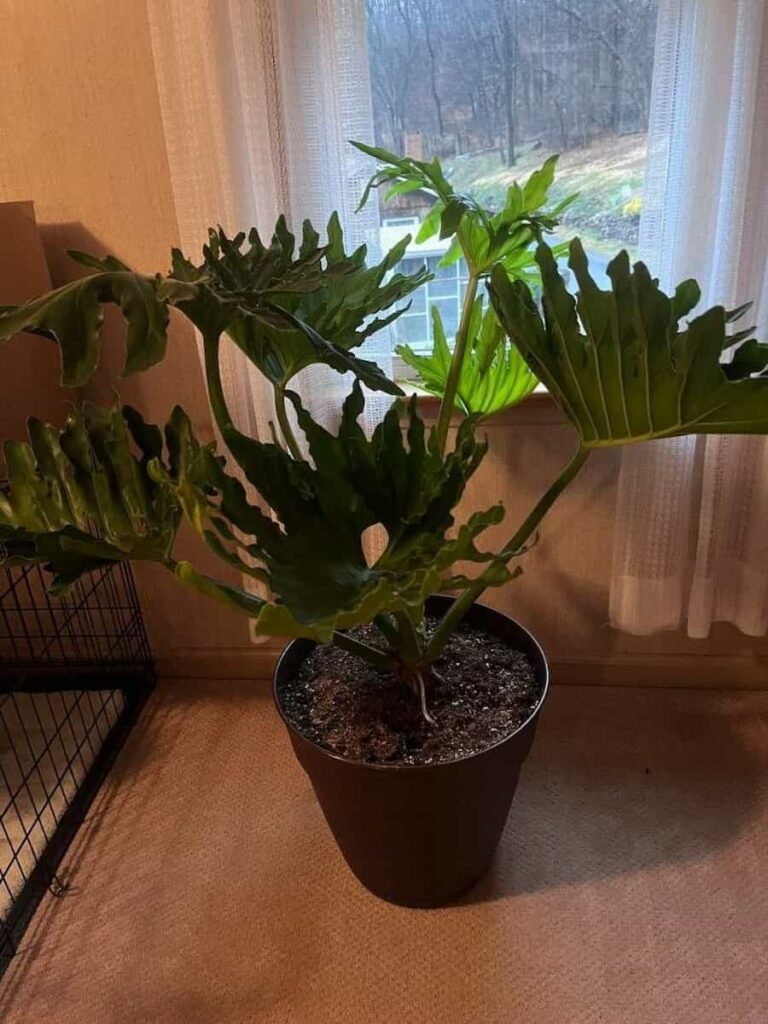
Therefore, if you notice yellowing leaves on your philodendron, run a diagnostic immediately. Is your soil damp or soggy? Allow it to dry out, which may reverse some of the damage. Lots of sun helps. Or if the damage is progressed, try repotting your Split Leaf Philodendron, removing damaging roots in the process.
A secondary cause of yellowing leaves is chemical burn, which your Split Leaf Philodendron may contract from over-fertilization. In this case, transplantation is also recommended, followed by a restriction of your feeding practices.
Why is my Split Leaf Philodendron drooping?
Drooping and wilting in Split Leaf Philodendron is more often than not related to watering practices. Too little water can cause fatigue which will make your plant look droopy, while too much water (or root rot) can also cause ill health. Generally, when a plant wilts, it is trying to communicate that it’s unwell.
While a drooping Split Leaf Philodendron is distressing, it’s not usually terribly serious and most likely due to dehydration. This can be solved with a dose of water and sunlight and, of course, more consistent care going forward. In no time, your plant should be back to its old self.
Conversely, if this doesn’t do the trick, your philodendron leaves curling may indicate an underlying issue like root rot, which, ironically, is caused by overwatering. If you suspect this is the case, you may be best off transplanting your Split Leaf Philodendron into fresh soil and readjusting your watering schedule.
A third cause of drooping is related to light. If a Split Leaf Philodendron isn’t receiving enough sun, it will tell you by dropping its leaves and wilting. Remember, six to eight hours a day is critical, and if you can’t provide this, mitigate potential drooping with supplementary grow lights.
Related: 10 Causes Of Your Philodendron Not Growing (+ How to Fix It)
Why are there brown spots on my Split Leaf Philodendron?
Like yellowing and drooping, brown spots on a Split Leaf Philodendron are a sign of a health ailment. Browning, in particular, is mainly caused by pest infestations or bacterial and fungal infections. The best way to get rid of brown spots is to identify the cause and then treat your plant accordingly.
None of us want to see our Split Leaf Philodendron suffer, and brown spots usually aren’t a very good sign. If you notice your philodendron leaves turning brown, the first thing you want to do is identify the cause, whether it be pests or soil-related.
In the case of creepy crawlies, you can treat your Split Leaf Philodendron by washing it down with a horticultural soap, followed by a wipe with neem oil. Remove damaged growth, and give your plant lots of love, water, and light.
On the other hand, bacterial and fungal infections are best treated by getting rid of old soil. I highly recommend transplanting your Split Leaf Philodendron (preferably in spring or summer), and cutting away any visible root and leaf damage, provided it’s not more than 30% of your plant’s total volume.
Brown spots on philodendrons can also be caused by sunburn, but in this case, they’ll look more like a sheen than a spot, per se. Sunburn can be prevented by keeping your Split Leaf Philodendron out of direct light.
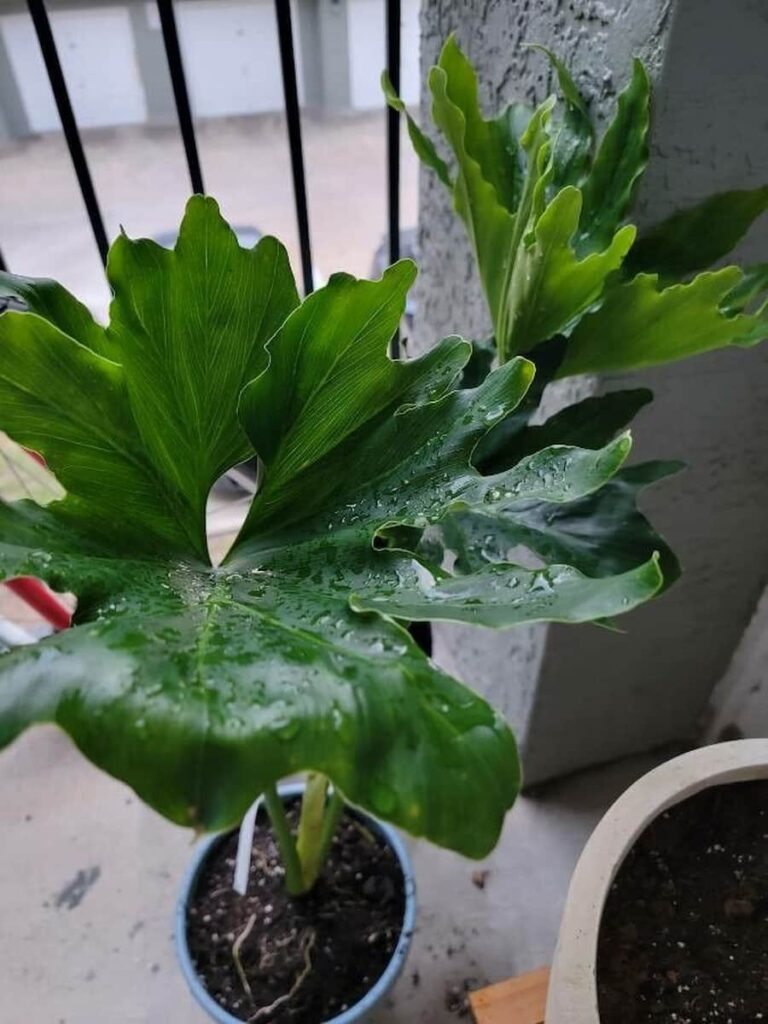
Why are my Split Leaf Philodendron’s leaves falling off?
When a Split Leaf Philodendron’s leaves start to drop, it is more often than not a sign of either overwatering or underwatering. Root rot, a consequence of too much water, can cause leaves to wilt, curl, and fall. Underwatering, conversely, sees them dry and turn crisp before dropping.
Brasils are great communicators and will tell you when there is something in their environment they don’t enjoy. As hardy plants, they don’t have many health issues, so any sudden onset of leaf drop is a cause for immediate concern.
As mentioned, this is usually related to watering practices, with the first sign of an issue being wilting, curling, or dried leaves. You should adapt your hydration timeframes accordingly.
If watering is not the problem, it may be that your Brasil is scorching (you’ll note its leaves start turning pink), in which case you should move it to a shadier spot as soon as possible.


